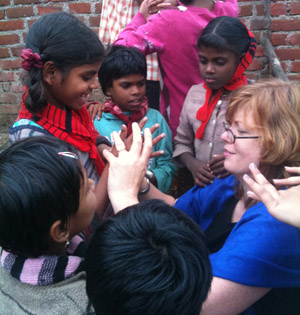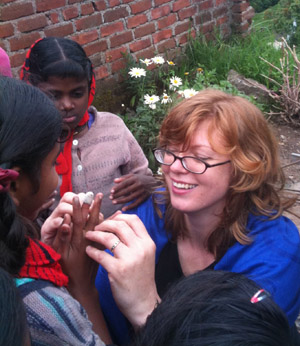Bulletin News

08/19/2010
For women in India, the wedding day often increases the risk from AIDS, according to SUNY Cortland health education faculty member Jena Curtis.
“The face of AIDS in India is too often that of a young widow in her late 20s or 30s,” said Curtis, an associate professor of health who joined the College in 2005.
About 2.27 million people in this country of 1 billion live with the disease, according to her. In some areas of India, almost 1 percent of the population is HIV positive. Only two countries, South Africa and Nigeria, have a greater number of citizens living with HIV/AIDS. In India, as in Africa, more than 80 percent of the infections come from heterosexual intercourse. Most Indian women with HIV were infected by their husbands.
“So unlike the U.S., where we say, ‘Wait until you’re married and you will be safe,’ in India, women incur all this risk once they’re married,” Curtis said.
The Indian government has focused its strongest intervention efforts on prostitutes and people who use intravenous drugs.
“AIDS education for the general public has not been the priority,” Curtis said.
Helping to train educators to deliver AIDS prevention messages is Curtis’ specialty. She completed dissertation research at Teacher’s College Columbia University on using online learning to teach pre- and in-service AIDS educators.
Curtis traveled to India on Aug. 1 to spend four weeks developing an AIDS prevention curriculum in collaboration with educators at the Kodaikanal International School. Located in the mountains of Tamul Nadu in the southern tip of India, Kodaikanal International School was established in 1901 and is the oldest co-educational school in all of India. She returned to the U.S. on Aug. 26.
Curtis will help create a comprehensive HIV/AIDS education and prevention curriculum for students from preschool to grade 12. She will work to prepare India’s teachers to start giving the youth of this country the knowledge they need to protect themselves and each other from the rapidly spreading, deadly worldwide epidemic.
“If we’re not educating people in school, then we can’t expect that people will be able to protect themselves.”
SUNY Cortland’s Research and Sponsored Programs Office recently awarded her $2,000 to offset her travel expenses. Her trip is also made possible by a grant to support her research work toward tenure at Cortland and an offer from the Kodaikanal International School to house and feed her during her stay in India.
In April 2008, Curtis was a keynote speaker at the Association of International Schools of India (TAISI) annual Teachers’ and Middle Management Conference in Bangalore, India. She spent a week doing workshops for teachers on how to incorporate AIDS prevention across the curriculum. Many of India’s schools don’t have health teachers, so she worked with teachers of biology and other sciences to find out how they might incorporate information about preventing the disease in other course subjects.
“They asked me to come back," she said. "So I’m going back to work with the school to develop a program school-wide.”
 |
| During her recent visit to India, Jena Curtis plays hand games as she works with children at the Tribal Children's Home, an educational center for orphans and disadvantaged children. |
The incorporation of HIV/AIDS curricula into public school classrooms is even more controversial in India than in the United States, Curtis asserts. Several state governments forbid sex education and individual teachers are reluctant to ask principals for permission to teach the subject.
“Because health education programs don’t typically exist in India’s classrooms, the average Indian student who gets into high school — which is only one in six of all students — will receive less than 20 hours of health education in his entire high school career,” Curtis said.
“In India there are media campaigns about condoms, but because the basic education isn’t there, it’s hard to have effective prevention messages,” she said.
Misinformation prevails, Curtis said. A research report published several years ago found that in rural villages Indian women refuse to use condoms to prevent AIDS because they think the latex receptacle will float around inside their bodies until it reaches their throats and chokes them to death.
“These women didn’t have a sense of their own reproductive anatomy and didn’t know that the reproductive system is closed and the condom couldn’t wander to their throats,” Curtis observed. “So it doesn’t work to say, ‘Wear a condom,’ if people don’t know that condoms are safe and can’t get lost in the rest of their body.”
Curtis will collaborate with teachers from the school to craft the delivery of AIDS education in a way that may resonate with students in southern India.
“This is the heart of health education,” said Curtis. “It’s working with indigenous people to identify what it is they need, what their cultural beliefs are, and then creating a health program that addresses their health needs while respecting their beliefs.”
One concern was that Indian teachers don’t necessarily know a lot about HIV and AIDS.
“The first week or so is going to be spent doing outreach with the teachers about how we might teach this,” Curtis said. “What are the issues? What are the problems? What are the cultural considerations? Then I’ll form a project team of teachers and staff who will work with me to help me figure out culturally appropriate ways to introduce this subject into Indian culture.
“In health, as in fashion, we’ve learned very quickly that one size does not fit all,” Curtis said. “Instead of coming in and saying, ‘I know how to fix things,’ I’m telling the people I work with that, ‘I have expertise on how to develop AIDS education but I really don’t know anything about life in Kodaikanal. I need you to teach me that.’ That’s how we do most things in health.”
She always asks educators to think about their own unique backgrounds and what their communities think about family. The answer is always the same: “We believe that family is the most important thing, and the parents’ job is to keep their children safe and love them and help them grow up to be strong and healthy.”
“Everyone, everywhere believes that,” Curtis said. “We think about what sort of stories and background there are to those feelings and then incorporate those into the curriculum. Is it a father’s job to protect his daughter? Is it a mother’s job to protect her daughter? And how do those things look?”
If you learn enough about the culture, you can then make lessons that mirror the values of the community and the way that those values are expressed, Curtis says. Then you have health education programs that people understand and respect.
Once the project has been developed, Kodaikanal’s excellent faculty and staff are tasked with sustaining the model, fulfilling a charter principal of the school that curriculum developed there will be exported. Curtis’ plan is to publish results of the project and follow up with teachers after her return to the U.S. to ensure the curriculum is fully implemented.
She is already planning her next trip back to India to expand the project.
“We could move to Delhi, Calcutta or Mumbai and pick another school in another region of India," she said. "The regions are very different so instead of creating one program for all of India, we are creating one for each region. I would love to bring one of my undergraduate health education students back with me to India next summer.”

